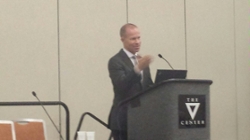What Threatens Compassionate Health Care?

“When we have a question, we ask Siri. ‘How can I help you?’ she says…I fear this is becoming a metaphor for doctors themselves,” says Brian Hodges, M.D., Ph.D., FRCPC, speaking about humanism in medicine at the annual conference of the Association of American Medical Colleges. He asks, “Are we on our way to becoming the ‘digital doctor?’” With all the advancements that technology and cutting-edge machinery bring to healthcare, it can also slice away at opportunities for compassion and patient bonding.
One of the most basic communicators of compassion—the human touch—is being replaced by instrumentation and cold, sterile metal. Hodges, a psychiatrist and a professor at the University of Toronto, recalls recently witnessing an operation; many years had passed since he had been present during an operation. He commented that it looked like some futuristic robotic sci-fi scene. “It used to be you were shoulder to shoulder with nurses and doctors. Now you’re shoulder to shoulder with machinery, and you don’t ever really have to touch the patient.”
Hodges notes that this distancing started a long time ago, citing the moment stethoscope inventor Rene Laennec inserted the stethoscope between him and his patient in order to better hear the heart and lungs. Touch is perhaps the most simple and direct communicator of compassion. Particularly for patients who have limitations, such as a patient with advanced dementia or infants. The warmth of the human hand can instantly and powerfully connect.
A more recent example of compassion disruption: Electronic medical records. They have taken the doctor’s eye-contact from the patient to the screen; interrupting the doctor-patient connection. “Many aspects [of medical technology] will greatly improve clinical care but they will also challenge us to consider, what is the role of the human?” says Hodges, an internationally respected researcher in compassion in health care. He co-founded the AMS Phoenix Project, which focuses on how health professionals provide the best care when they can balance human compassion with technical expertise—“person-centered care.”
“People are disappearing from all kinds of tasks,” says Hodges, who admits he often uses airline travel analogies since he often finds himself on airplanes. He notes that he can check in, get his baggage tags, and even forego the bulk of security personnel interaction before he even sees anyone. “Where are all the people?” he quips.
Before a flight takes off, we’re reminded to use our oxygen mask first before helping one another. “Are our doctors getting the oxygen they need?” asks Hodges. “If we’re not taking care of our doctors, how can they help others get well.“ He posits that creating and sustaining an environment that supports compassion may cost less than the litigation, absenteeism, compromised quality of care and inefficiencies that can stem from doctor burnout and depression. “We have to remember that the relationship between patients and clinicians can make us all better.”
Hodges suspects doctors in the future will face even more challenges, citing a recent Economist article—“Professor Dr. Robot”—about how technology is usurping and upsetting the role of many professionals. It points out that every month 190 million people visit WebMD through the app—more than visit regular doctors in America. Hodges reminds us that at its core, the practice of medicine is simply one human being caring for another.
Peta Owens-Liston is a Communications Specialist at University of Utah Health Sciences/ARUP
